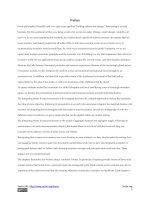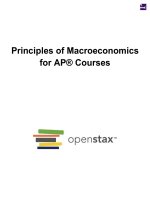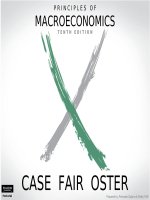Principles of macroeconomics 10e by case fair oster ch05
Bạn đang xem bản rút gọn của tài liệu. Xem và tải ngay bản đầy đủ của tài liệu tại đây (945.05 KB, 38 trang )
PRINCIPLES OF
MACROECONOMICS
PART II Concepts and Problems in Macroeconomics
TENTH
EDITION
CASE FAIR OSTER
© 2012 Pearson Education, Inc. Publishing as Prentice Hall
Prepared by: Fernando Quijano & Shelly
1 ofTefft
38
PART II Concepts and Problems in Macroeconomics
© 2012 Pearson Education, Inc. Publishing as Prentice Hall
2 of 38
PART II CONCEPTS AND PROBLEMS
IN MACROECONOMICS
Introduction to
Macroeconomics
5
CHAPTER OUTLINE
Macroeconomic Concerns
Output Growth
Unemployment
Inflation and Deflation
PART II Concepts and Problems in Macroeconomics
The Components of the Macroeconomy
© 2012 Pearson Education, Inc. Publishing as Prentice Hall
The Circular Flow Diagram
The Three Market Arenas
The Role of the Government in the Macroeconomy
A Brief History of Macroeconomics
The U.S. Economy Since 1970
3 of 38
microeconomics Examines the functioning of individual industries and
the behavior of individual decision-making units—firms and households.
PART II Concepts and Problems in Macroeconomics
macroeconomics Deals with the economy as a whole.
Macroeconomics focuses on the determinants of total national income,
deals with aggregates such as aggregate consumption and investment,
and looks at the overall level of prices instead of individual prices.
aggregate behavior The behavior of all households and firms together.
sticky prices Prices that do not always adjust rapidly to maintain
equality between quantity supplied and quantity demanded.
© 2012 Pearson Education, Inc. Publishing as Prentice Hall
4 of 38
PART II Concepts and Problems in Macroeconomics
Which of the following statements is correct?
a.
Macroeconomics examines the behavior of individual
industries.
b.
Both macroeconomics and microeconomics are concerned
with the decisions of households and firms.
c.
Microeconomists look for macroeconomic foundations to
explain why most markets arrive at equilibrium.
d.
All of the above.
© 2012 Pearson Education, Inc. Publishing as Prentice Hall
5 of 38
PART II Concepts and Problems in Macroeconomics
Which of the following statements is correct?
a.
Macroeconomics examines the behavior of individual
industries.
b. Both macroeconomics and microeconomics are
concerned with the decisions of households and firms.
c.
Microeconomists look for macroeconomic foundations to
explain why most markets arrive at equilibrium.
d.
All of the above.
© 2012 Pearson Education, Inc. Publishing as Prentice Hall
6 of 38
Macroeconomic Concerns
Three of the major concerns of macroeconomics are
Output growth
Unemployment
PART II Concepts and Problems in Macroeconomics
Inflation and deflation
© 2012 Pearson Education, Inc. Publishing as Prentice Hall
7 of 38
Macroeconomic Concerns
Output Growth
business cycle The cycle of short-term ups and downs in the
economy.
PART II Concepts and Problems in Macroeconomics
aggregate output The total quantity of goods and services produced
in an economy in a given period.
recession A period during which aggregate output declines.
Conventionally, a period in which aggregate output declines for two
consecutive quarters.
depression A prolonged and deep recession.
© 2012 Pearson Education, Inc. Publishing as Prentice Hall
8 of 38
PART II Concepts and Problems in Macroeconomics
For economists, the main measure of how an economy is doing is:
a.
Aggregate output.
b.
Aggregate employment.
c.
The aggregate price level.
d.
The growth rate of the population.
© 2012 Pearson Education, Inc. Publishing as Prentice Hall
9 of 38
PART II Concepts and Problems in Macroeconomics
For economists, the main measure of how an economy is doing is:
a.
Aggregate output.
b.
Aggregate employment.
c.
The aggregate price level.
d.
The growth rate of the population.
© 2012 Pearson Education, Inc. Publishing as Prentice Hall
10 of 38
Macroeconomic Concerns
Output Growth
expansion or boom The period in the business cycle from a trough up
to a peak during which output and employment grow.
PART II Concepts and Problems in Macroeconomics
contraction, recession, or slump The period in the business cycle
from a peak down to a trough during which output and employment fall.
© 2012 Pearson Education, Inc. Publishing as Prentice Hall
11 of 38
Macroeconomic Concerns
Output Growth
PART II Concepts and Problems in Macroeconomics
FIGURE 5.1 A Typical Business
Cycle
In this business cycle, the
economy is expanding as it
moves through point A from
the trough to the peak.
When the economy moves
from a peak down to a trough,
through point B, the economy
is in recession.
© 2012 Pearson Education, Inc. Publishing as Prentice Hall
12 of 38
Macroeconomic Concerns
PART II Concepts and Problems in Macroeconomics
Output Growth
FIGURE 5.2 U.S. Aggregate Output (Real GDP), 1900–2009
The periods of the Great Depression and World Wars I and II show the largest fluctuations in aggregate output.
© 2012 Pearson Education, Inc. Publishing as Prentice Hall
13 of 38
Macroeconomic Concerns
Unemployment
PART II Concepts and Problems in Macroeconomics
unemployment rate The percentage of the labor force that is
unemployed.
© 2012 Pearson Education, Inc. Publishing as Prentice Hall
14 of 38
PART II Concepts and Problems in Macroeconomics
In microeconomic theory, which of the following happens as the
labor market eliminates unemployment and restores its
equilibrium?
a.
The equilibrium wage rises above the wage that prevailed
when there was unemployment.
b.
As it moves toward equilibrium, the market experiences
an increase in the quantity of labor demanded and a decrease in
the quantity supplied.
c.
The market will turn a shortage into a surplus.
d.
Supply and demand will shift, but equilibrium price remain
the same in the end.
© 2012 Pearson Education, Inc. Publishing as Prentice Hall
15 of 38
PART II Concepts and Problems in Macroeconomics
In microeconomic theory, which of the following happens as the
labor market eliminates unemployment and restores its
equilibrium?
a.
The equilibrium wage rises above the wage that prevailed
when there was unemployment.
b.
As it moves toward equilibrium, the market
experiences an increase in the quantity of labor demanded
and a decrease in the quantity supplied.
c.
The market will turn a shortage into a surplus.
d.
Supply and demand will shift, but equilibrium price remain
the same in the end.
© 2012 Pearson Education, Inc. Publishing as Prentice Hall
16 of 38
Macroeconomic Concerns
Inflation and Deflation
inflation An increase in the overall price level.
PART II Concepts and Problems in Macroeconomics
hyperinflation A period of very rapid increases in the overall price
level.
deflation A decrease in the overall price level.
© 2012 Pearson Education, Inc. Publishing as Prentice Hall
17 of 38
The Components of the Macroeconomy
Understanding how the macroeconomy works can be challenging because a
great deal is going on at one time. Everything seems to affect everything else.
To see the big picture, it is helpful to divide the participants in the economy into
four broad groups:
PART II Concepts and Problems in Macroeconomics
(1) Households.
(2) Firms.
(3) The government.
(4) The rest of the world.
© 2012 Pearson Education, Inc. Publishing as Prentice Hall
18 of 38
The Components of the Macroeconomy
The Circular Flow Diagram
PART II Concepts and Problems in Macroeconomics
circular flow A diagram showing the income received and payments
made by each sector of the economy.
transfer payments Cash payments made by the government to
people who do not supply goods, services, or labor in exchange for
these payments. They include Social Security benefits, veterans’
benefits, and welfare payments.
© 2012 Pearson Education, Inc. Publishing as Prentice Hall
19 of 38
The Components of the Macroeconomy
The Circular Flow Diagram
PART II Concepts and Problems in Macroeconomics
FIGURE 5.3 The Circular Flow of
Payments
Households receive income from firms and
the government, purchase goods and
services from firms, and pay taxes to the
government.
They also purchase foreign-made goods
and services (imports).
Firms receive payments from households
and the government for goods and services;
they pay wages, dividends, interest, and
rents to households and taxes to the
government.
The government receives taxes from firms
and households, pays firms and households
for goods and services—including wages to
government workers—and pays interest and
transfers to households.
Finally, people in other countries purchase
goods and services produced domestically
(exports).
Note: Although not shown in this diagram,
firms and governments also purchase
imports.
© 2012 Pearson Education, Inc. Publishing as Prentice Hall
20 of 38
The Components of the Macroeconomy
The Three Market Arenas
Another way of looking at the ways households, firms, the
government, and the rest of the world relate to one another is to
consider the markets in which they interact.
PART II Concepts and Problems in Macroeconomics
We divide the markets into three broad arenas:
(1) The goods-and-services market.
(2) The labor market.
(3) The money (financial) market.
© 2012 Pearson Education, Inc. Publishing as Prentice Hall
21 of 38
The Components of the Macroeconomy
The Three Market Arenas
Goods-and-Services Market
Firms supply to the goods-and-services market. Households,
the government, and firms demand from this market.
PART II Concepts and Problems in Macroeconomics
Labor Market
In this market, households supply labor and firms and the
government demand labor.
© 2012 Pearson Education, Inc. Publishing as Prentice Hall
22 of 38
The Components of the Macroeconomy
The Three Market Arenas
Money Market
PART II Concepts and Problems in Macroeconomics
Households supply funds to this market in the expectation of
earning income in the form of dividends on stocks and
interest on bonds.
Much of the borrowing and lending of households, firms, the
government, and the rest of the world are coordinated by
financial institutions.
© 2012 Pearson Education, Inc. Publishing as Prentice Hall
23 of 38
The Components of the Macroeconomy
The Three Market Arenas
Money Market
PART II Concepts and Problems in Macroeconomics
Treasury bonds, notes, and bills Promissory notes issued
by the federal government when it borrows money.
corporate bonds Promissory notes issued by firms when
they borrow money.
shares of stock Financial instruments that give to the
holder a share in the firm’s ownership and therefore the right
to share in the firm’s profits.
dividends The portion of a firm’s profits that the firm pays
out each period to its shareholders.
© 2012 Pearson Education, Inc. Publishing as Prentice Hall
24 of 38
PART II Concepts and Problems in Macroeconomics
All of the following are debt instruments, or promissory notes
issued by a borrower, except one. Which one?
a.
Treasury bonds.
b.
Treasury notes.
c.
Treasury bills.
d.
Corporate Stocks.
e.
Corporate bonds.
© 2012 Pearson Education, Inc. Publishing as Prentice Hall
25 of 38









